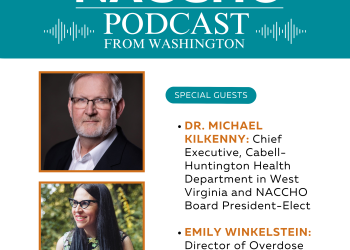Local health departments (LHDs) play a vital role in providing immunization services and counseling, as well as in controlling cases of vaccine-preventable diseases. These local agencies work with public and private sector physicians and other stakeholders to ensure effective immunization practices, disease surveillance and reporting, education and outreach, and program oversight. In November 2017, NACCHO, with support from the Centers for Disease Control and Prevention (CDC) and the Association of Immunization Managers (AIM), conducted the 2017 NACCHO Assessment of Local Health Department Immunization Programs. The assessment results showcase the strengths and best practices of high performing immunization programs and highlight opportunities to enhance and leverage federal, state, and local resources to improve local immunization program efforts.
The assessment was distributed online via Qualtrics Survey SoftwareTM to a representative sample of 2,238 participants who work in LHD immunization programs throughout the country. Participants were asked to respond to 38 closed and open-ended questions regarding their immunization program’s infrastructure, activities, priorities, immunization information systems, billing mechanisms, and partnerships. A total of 517 (23%) participants completed the assessment providing further insight into local immunization programs.
Key highlights from the assessment include:
- 25% of participants reported a decrease over the past year in immunization program staffing. Additionally, 41% of respondents currently have fewer than 2 FTEs conducting immunization activities and services.
- The most frequently reported immunization program activities include hosting immunization clinics, conducting education and outreach, collaborating with internal LHD programs, providing immunizations for children and adolescents, and conducting communication campaigns.
- The top barriers to immunization programs include vaccine hesitancy, insufficient staffing, lack of education or confidence in vaccines among patients/parents, lack of program funding, and an increase in VFC requirements.
- The top priorities that LHD immunization programs would like to address include vaccine rates, vaccine confidence, establishing partnerships, immunization information systems, and providing technical assistance and education.
- Though 80% of participants indicated that their LHD immunization program can bill public payers, only 56% have the capability to bill private insurance companies.
- LHD immunization programs most frequently partner with schools, other health departments, individual healthcare providers, healthcare clinics, and hospitals.
This assessment represents a significant contribution by LHD immunization program staff to the knowledge base of local immunization efforts. Assessment findings reaffirmed that LHDs are well-situated to deliver comprehensive immunization services and counseling and are uniquely positioned to increase immunization coverage rates and address vaccination coverage disparities. Through this research, NACCHO will continue to advocate for, provide capacity building assistance to, and promote the work of LHD immunization programs.
For more information about the assessment results and NACCHO’s specific recommendations, view the assessment supplemental infographic. Please contact NACCHO’s Immunization program with questions: [email protected].


